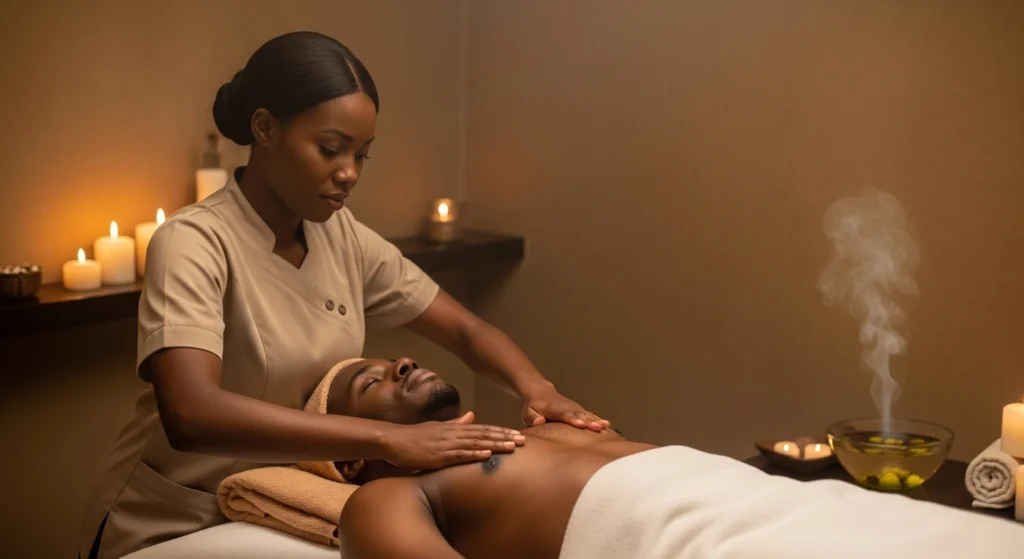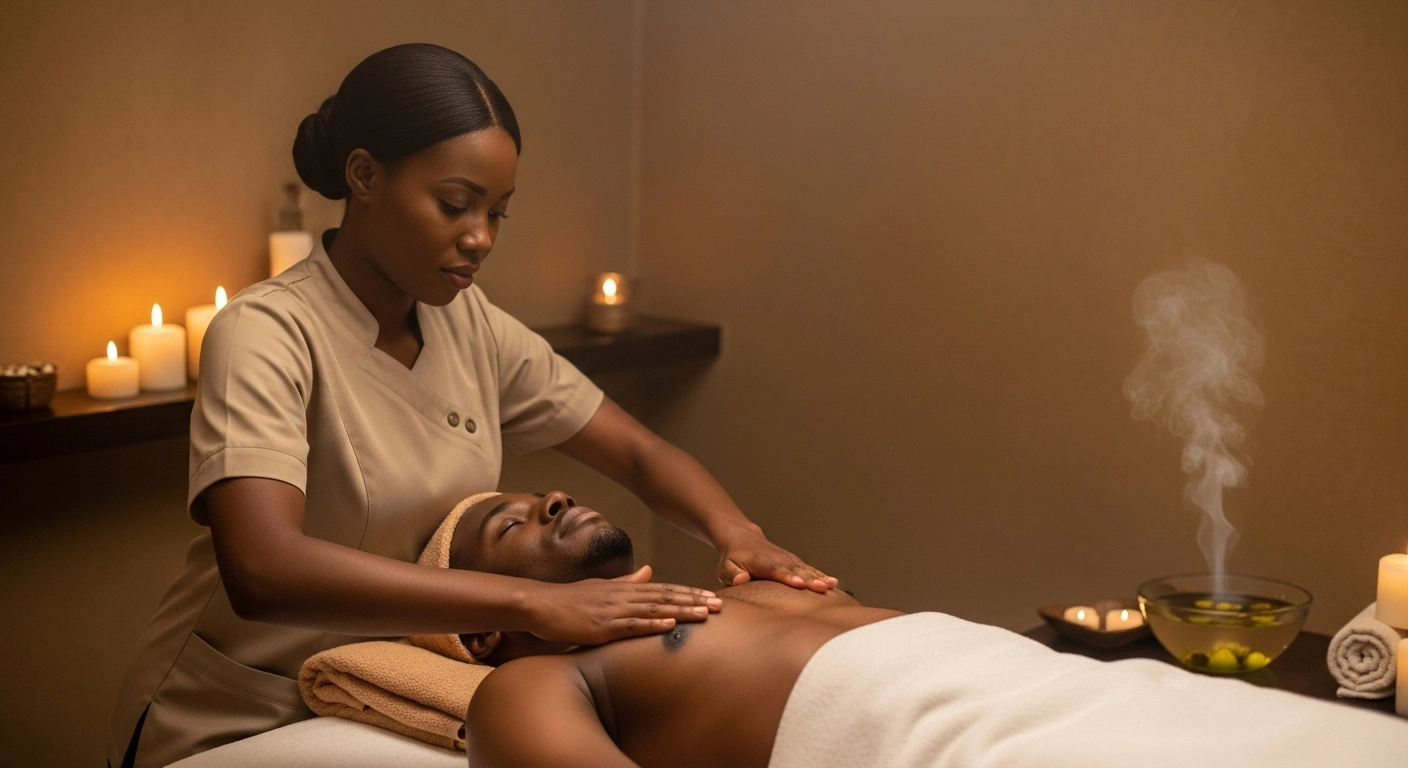You know that feeling when something seems like it should be helpful, but then you wonder if it’s actually safe for your specific situation? That’s exactly what happens when people discover breast massage therapy and start questioning whether it’s right for them. Maybe you’re dealing with a recent surgery, have an ongoing medical condition, or you’re pregnant and unsure about what’s safe. The internet is flooded with conflicting information, leaving you more confused than when you started your research.
Here’s where we come in to clear the air and give you the straight facts you’ve been searching for. At Lebien etre, we’ve worked with countless clients who faced these same concerns, and we understand that knowing the contraindications isn’t about scaring you away from beneficial therapy – it’s about keeping you safe while maximizing the incredible benefits. We’re going to walk you through exactly when breast massage should be avoided, when it might need modifications, and how to make informed decisions about your wellness journey. Think of this as your comprehensive guide to navigating the do’s and don’ts, written by professionals who’ve seen it all.
What Are Contraindications and Why They Matter
Let me tell you something that might surprise you – contraindications aren’t just medical jargon meant to complicate your life. They’re actually your safety net, designed to protect you from potential harm while ensuring you get the maximum benefit from Breast Massage Service. Contraindications are specific conditions, circumstances, or factors that make a particular treatment inadvisable or potentially dangerous.
Think of contraindications like traffic lights for your body. Just as you wouldn’t drive through a red light because it could cause an accident, you shouldn’t proceed with certain therapies when your body is showing “red light” conditions. We’ve categorized these into absolute contraindications (complete no-go situations) and relative contraindications (proceed with caution scenarios).
The beauty of understanding these guidelines is that they actually open more doors than they close. When you know what to watch for, you can work with qualified therapists to modify techniques or timing to suit your unique situation. It’s not about limiting your options – it’s about making smarter, safer choices for your health and wellness journey.
Absolute Contraindications: When to Avoid Breast Massage Completely
Active Infections and Inflammatory Conditions
Here’s something we see far too often in our practice – people trying to “massage away” what they think is just tension, when they’re actually dealing with an active infection. Mastitis, cellulitis, or any localized infection in the breast area is an absolute no-go for massage therapy. The pressure and manipulation can actually spread the infection or make symptoms significantly worse.
Inflammatory breast cancer is another serious condition that requires immediate medical attention, not massage therapy. The symptoms can sometimes be mistaken for less serious conditions, which is why we always recommend getting unusual breast changes evaluated by a healthcare provider first. If you’re experiencing sudden redness, warmth, swelling, or skin that looks like an orange peel, skip the massage and head straight to your doctor.
We also need to talk about acute thrombophlebitis – blood clots in the vessels near the chest area. Massage pressure could potentially dislodge a clot, creating a life-threatening situation. This is exactly why our therapists at Lebien etre always conduct thorough health screenings before any treatment.
Recent Surgical Procedures
I can’t tell you how many times we’ve had clients ask about massage just days after breast surgery, thinking it will speed up healing. While Pre and Post Surgery massage can be incredibly beneficial, timing is absolutely crucial. Fresh surgical sites need time to heal properly before any external pressure is applied.
Most surgeons recommend waiting 4-6 weeks after breast surgery before considering any form of massage therapy. This includes breast augmentation, reduction, mastectomy, or even minor procedures like cyst removal. The tissue needs time to establish proper blood flow and begin the healing process without external interference.
Open wounds, fresh scars, or areas with sutures are obvious no-massage zones. Even if the surgery was weeks ago, if there are any signs of infection, delayed healing, or complications, massage should be postponed until you get medical clearance.
Cancer-Related Considerations
This is probably the most complex area we deal with, and honestly, it’s where having professional guidance becomes absolutely essential. Active breast cancer being treated with chemotherapy or radiation requires extreme caution. The treatment protocols can affect your immune system, blood clotting, and tissue sensitivity in ways that make standard massage techniques inappropriate.
Lymphedema is another serious consideration, especially for breast cancer survivors. While specialized Lymphatic System Health massage can be beneficial, it requires specific training and techniques. Regular breast massage could actually worsen lymphatic congestion if not performed correctly.
We always, and I mean always, require medical clearance from oncologists before working with cancer patients or survivors. Every case is unique, and what’s safe for one person might not be appropriate for another.
Relative Contraindications: Proceed with Caution
Pregnancy and Breastfeeding Considerations
Pregnancy brings up so many questions about what’s safe and what isn’t, and breast massage is no exception. During the first trimester, many healthcare providers recommend avoiding breast massage entirely due to concerns about stimulating hormone production that could potentially affect the pregnancy. However, this varies significantly from person to person.
Breastfeeding mothers face a different set of considerations. While Safe Breast Massage can be incredibly helpful for engorgement and blocked ducts, the timing and technique matter enormously. Massage right before feeding can actually interfere with the natural let-down reflex.
Postpartum Breast Massage can provide amazing relief for new mothers, but we always coordinate with your healthcare provider to ensure timing is appropriate. High-risk pregnancies or complicated deliveries may require longer waiting periods before massage therapy is advisable.
Medication Interactions and Health Conditions
This is where things get really personalized, and why we spend so much time on health history intake. Blood-thinning medications like warfarin, aspirin therapy, or newer anticoagulants can increase bruising risk and require modified pressure techniques. We don’t avoid massage entirely, but we definitely adjust our approach.
Autoimmune conditions like lupus, rheumatoid arthritis, or fibromyalgia can make tissues more sensitive and unpredictable in their response to massage. Some days these clients feel amazing after treatment, other days the same technique might cause flare-ups. It’s all about reading your body’s signals and maintaining open communication with your therapist.
People with diabetes need special consideration due to potential circulation issues and slower healing times. Heart conditions, especially those involving irregular rhythms or recent cardiac events, may require medical clearance before massage therapy.
Acute Medical Situations
Sometimes your body is simply too overwhelmed with other issues to benefit from massage therapy. High fever, acute illness, or severe fatigue are your body’s way of saying “not today.” We’ve learned to listen to these signals rather than push through them.
Skin conditions like eczema, psoriasis flare-ups, or unexplained rashes in the treatment area need evaluation before massage. Sometimes massage can help, sometimes it can make things worse – it really depends on the underlying cause and current state of the condition.
Severe emotional distress or acute anxiety can also make massage counterproductive. While Upper Body Comfort massage can be wonderfully relaxing, if you’re in crisis mode, you might need other forms of support first.
Understanding the Difference: When Professional Help Is Essential
Therapeutic vs Self-Care Approaches
Here’s something that surprises many people – not all massage techniques are created equal, and some require professional training to perform safely. Therapeutic vs Self-Massage becomes especially important when you’re dealing with medical conditions or complex health situations. Self-massage is wonderful for general wellness and maintenance, but therapeutic work requires deeper knowledge of anatomy, pathology, and proper technique modification.
Professional therapists are trained to recognize warning signs, adjust pressure appropriately, and know when to refer you to medical professionals. We understand the intricate relationships between different body systems and how conditions like lymphedema, post-surgical healing, or pregnancy affect tissue response. This knowledge isn’t something you can pick up from online videos or general wellness articles.
The Medical Benefits of professional therapy extend far beyond what most people realize. We’re not just working on muscle tension – we’re supporting lymphatic drainage, improving circulation, addressing scar tissue, and helping your body maintain optimal function.
Specialized Techniques for Complex Conditions
Different conditions require completely different approaches, and this is where professional training becomes absolutely crucial. The Breast Massage Techniques we use for someone with lymphedema are entirely different from those we’d use for general tension relief or Big breasts massage support.
Manual lymphatic drainage requires specific hand positions, pressure levels, and directional movements that can’t be learned casually. Scar tissue work needs understanding of tissue healing phases and how to encourage proper collagen alignment. Cancer-related massage involves knowledge of treatment side effects, medication interactions, and when to avoid certain areas entirely.
We’ve spent years learning these specialized techniques because we’ve seen firsthand how much more effective and safer professional treatment can be. It’s not about creating dependency – it’s about ensuring you get the best possible results while minimizing any risk of complications.
Red Flags: When to Stop and Seek Medical Attention
Immediate Warning Signs During Treatment
Let’s talk about the signs that mean “stop everything right now” during any breast massage session. Sharp, shooting pain that doesn’t subside when pressure is removed is a major red flag. This could indicate nerve irritation, underlying tissue damage, or a condition that needs immediate medical evaluation. We teach all our clients to speak up immediately if they experience this kind of pain.
Sudden onset of nausea, dizziness, or feeling faint during massage can indicate a vasovagal response or other systemic issue. While this isn’t necessarily dangerous, it means we need to stop treatment and assess what’s happening. Unusual warmth, redness, or swelling that develops during or immediately after massage could signal an inflammatory response that needs attention.
Severe bruising beyond what would be expected from the pressure used, or bruising that appears in patterns inconsistent with the massage technique, could indicate underlying bleeding disorders or other medical conditions. We document everything carefully so we can track patterns and identify potential issues early.
Post-Treatment Concerns
The hours and days following massage can provide important information about how your body is responding to treatment. Persistent pain that lasts more than 24-48 hours after treatment, especially if it’s worse than any discomfort you had before the massage, needs evaluation. Some soreness is normal, but escalating pain is not.
New lumps, bumps, or changes in breast tissue noticed after massage should be evaluated by a healthcare provider. While massage doesn’t cause these changes, the increased awareness of your body might help you notice things that were already there. Changes in nipple discharge, either new discharge or changes in existing discharge, should always be checked out medically.
Signs of infection like fever, red streaking, or areas that feel hot to the touch require immediate medical attention. While rare, any bodywork can occasionally introduce bacteria if proper hygiene isn’t maintained, or it might reveal an underlying infection that was already developing.
Creating Your Personal Safety Protocol
Pre-Treatment Health Assessment
We’ve developed a comprehensive assessment process over the years because we’ve learned that every client’s situation is unique. Your medical history isn’t just a formality – it’s the foundation of safe, effective treatment. We need to know about current medications, recent surgeries, ongoing health conditions, and any changes in your body that might affect treatment.
Current symptoms get detailed attention because they can change our entire approach. That slight tenderness you mentioned might be nothing, or it might indicate we need to modify pressure or avoid certain areas entirely. Hormonal factors like where you are in your menstrual cycle, pregnancy status, or hormone replacement therapy all affect tissue sensitivity and response.
We also discuss your goals and expectations because understanding what you’re hoping to achieve helps us determine if massage therapy is the right approach for your situation. Sometimes we recommend other treatments first, or suggest combining massage with other therapies for optimal results.
Building Communication with Your Healthcare Team
Here’s something that’s absolutely essential but often overlooked – your massage therapist should be part of your broader healthcare team, not working in isolation. We encourage all our clients to keep their primary care physicians, specialists, and other healthcare providers informed about their massage therapy. Open communication between providers leads to better outcomes and safer treatment.
Medical clearance isn’t just a formality for certain conditions – it’s a collaborative approach to your health. When we have questions about whether massage is appropriate for your situation, we’re not being overly cautious, we’re being professionally responsible. Your doctor has information about your overall health picture that we might not have.
We also provide treatment notes to healthcare providers when requested, documenting what techniques we used, how you responded, and any observations that might be relevant to your overall care. This collaborative approach has led to some amazing success stories and helped identify potential issues before they became serious problems.
Ongoing Monitoring and Adjustment
Your health isn’t static, and neither should your massage therapy approach be. We regularly reassess your condition, response to treatment, and any changes in your health status. Regular check-ins help us adjust techniques, pressure, frequency, and focus areas as needed. What worked perfectly three months ago might need modification today.
Treatment documentation helps us track patterns over time. Are you consistently sore after certain techniques? Do symptoms improve or worsen with different approaches? This information guides our treatment modifications and helps identify the most effective strategies for your unique situation.
We also educate our clients on self-monitoring between sessions. Knowing what to watch for, when to be concerned, and how to communicate changes effectively makes the entire treatment process safer and more effective. You become an active partner in your care rather than a passive recipient.
Conclusion: Making Informed Decisions About Your Health
Understanding contraindications for breast massage therapy isn’t about creating fear or limiting your options – it’s about empowering you to make informed decisions about your health and wellness. The goal is always to maximize benefits while minimizing risks, and that requires honest assessment of your individual situation, open communication with qualified professionals, and respect for your body’s current needs and limitations.
Remember that contraindications can be temporary. A condition that makes massage inadvisable today might resolve in a few weeks or months, opening up new treatment possibilities. The key is patience, professional guidance, and staying informed about your options as your health situation evolves.
At Lebien etre, we’re committed to providing safe, effective breast massage therapy that respects your individual circumstances and health needs. Whether you’re exploring massage for general wellness, specific medical benefits, or as part of a broader health strategy, we’re here to guide you through the process safely and effectively.







